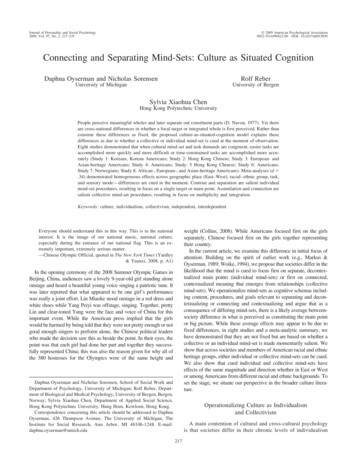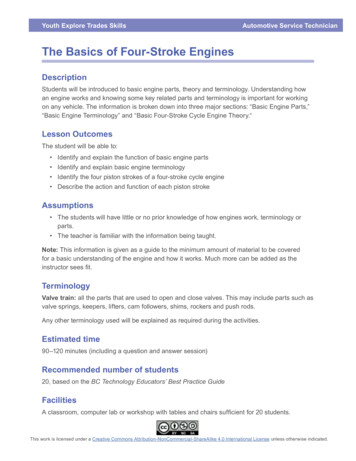
Transcription
Journal of Personality and Social Psychology2009, Vol. 97, No. 2, 217–235 2009 American Psychological Association0022-3514/09/ 12.00 DOI: 10.1037/a0015850Connecting and Separating Mind-Sets: Culture as Situated CognitionDaphna Oyserman and Nicholas SorensenRolf ReberUniversity of MichiganUniversity of BergenSylvia Xiaohua ChenHong Kong Polytechnic UniversityPeople perceive meaningful wholes and later separate out constituent parts (D. Navon, 1977). Yet thereare cross-national differences in whether a focal target or integrated whole is first perceived. Rather thanconstrue these differences as fixed, the proposed culture-as-situated-cognition model explains thesedifferences as due to whether a collective or individual mind-set is cued at the moment of observation.Eight studies demonstrated that when cultural mind-set and task demands are congruent, easier tasks areaccomplished more quickly and more difficult or time-constrained tasks are accomplished more accurately (Study 1: Koreans, Korean Americans; Study 2: Hong Kong Chinese; Study 3: European- andAsian-heritage Americans; Study 4: Americans; Study: 5 Hong Kong Chinese; Study 6: Americans;Study 7: Norwegians; Study 8: African-, European-, and Asian-heritage Americans). Meta-analyses (d .34) demonstrated homogeneous effects across geographic place (East–West), racial– ethnic group, task,and sensory mode— differences are cued in the moment. Contrast and separation are salient individualmind-set procedures, resulting in focus on a single target or main point. Assimilation and connection aresalient collective mind-set procedures, resulting in focus on multiplicity and integration.Keywords: culture, individualism, collectivism, independent, interdependentweight (Collins, 2008). While Americans focused first on the girlsseparately, Chinese focused first on the girls together representingtheir country.In the current article, we examine this difference in initial focus ofattention. Building on the spirit of earlier work (e.g., Markus &Oyserman, 1989; Woike, 1994), we propose that societies differ in thelikelihood that the mind is cued to focus first on separate, decontextualized main points (individual mind-sets) or first on connected,contextualized meaning that emerges from relationships (collectivemind-sets). We operationalize mind-sets as cognitive schemas including content, procedures, and goals relevant to separating and decontextualizing or connecting and contextualizing and argue that as aconsequence of differing mind-sets, there is a likely average betweensociety difference in what is perceived as constituting the main pointor big picture. While these average effects may appear to be due tofixed differences, in eight studies and a meta-analytic summary, wehave demonstrated that they are not fixed but are based on whether acollective or an individual mind-set is made momentarily salient. Weshow that across societies and members of American racial and ethnicheritage groups, either individual or collective mind-sets can be cued.We also show that cued individual and collective mind-sets haveeffects of the same magnitude and direction whether in East or Westor among Americans from different racial and ethnic backgrounds. Toset the stage, we situate our perspective in the broader culture literature.Everyone should understand this in this way. This is in the nationalinterest. It is the image of our national music, national culture,especially during the entrance of our national flag. This is an extremely important, extremely serious matter.—Chinese Olympic Official, quoted in The New York Times (Yardley& Yuanxi, 2008, p. A1)In the opening ceremony of the 2008 Summer Olympic Games inBeijing, China, audiences saw a lovely 9-year-old girl standing aloneonstage and heard a beautiful young voice singing a patriotic tune. Itwas later reported that what appeared to be one girl’s performancewas really a joint effort. Lin Miaoke stood onstage in a red dress andwhite shoes while Yang Peiyi was offstage, singing. Together, prettyLin and clear-toned Yang were the face and voice of China for thisimportant event. While the American press implied that the girlswould be harmed by being told that they were not pretty enough or notgood enough singers to perform alone, the Chinese political leaderswho made the decision saw this as beside the point. In their eyes, thepoint was that each girl had done her part and together they successfully represented China; this was also the reason given for why all ofthe 380 hostesses for the Olympics were of the same height andDaphna Oyserman and Nicholas Sorensen, School of Social Work andDepartment of Psychology, University of Michigan; Rolf Reber, Department of Biological and Medical Psychology, University of Bergen, Bergen,Norway; Sylvia Xiaohua Chen, Department of Applied Social Science,Hong Kong Polytechnic University, Hung Hom, Kowloon, Hong Kong.Correspondence concerning this article should be addressed to DaphnaOyserman, 426 Thompson Avenue, The University of Michigan, TheInstitute for Social Research, Ann Arbor, MI 48106-1248. E-mail:daphna.oyserman@umich.eduOperationalizing Culture as Individualismand CollectivismA main contention of cultural and cross-cultural psychologyis that societies differ in their chronic levels of individualism217
218OYSERMAN, SORENSEN, REBER, AND CHENand collectivism and that these differences have consequencesbeyond differences in values (e.g., Inglehart & Oyserman,2004; Triandis, 1995). Specifically, individualism and collectivism are associated with differences in content of selfconcept, ways of engaging others, and cognitive style (forreviews, see Markus & Kitayama, 1991; Nisbett, 2003; Oyserman, Coon, & Kemmelmeier, 2002). We focus explicitly oncollectivism and individualism as core axes within the broaderand more heterogeneous construct of culture for a number ofreasons. First, collectivism and individualism form the cornerstones of a number of central theoretical advances in the growing field of cultural and cross-cultural psychology (for reviews,see Markus & Kitayama, 1991; Nisbett, 2003; Oyserman, Kemmelmeier, & Coon, 2002; Oyserman & Sorensen, 2009; Triandis, 1995). Second, they provide broadly contrasting organizingframeworks for understanding and meaning making. Third, theindividualism and collectivism distinction is empirically supported, as we outline below.Implications of Individualism and Collectivism:Social KnowledgeCross-national comparisons of countries assumed to differ inindividualism and collectivism focus on theoretically associateddifferences in values, self-concepts, styles of emotional expression, and relationships. With regard to values, essential values ofindividualism are reported to be individual freedom, personalfulfillment, autonomy, and separation, while, for collectivism,essential values focus on group membership, loyalty, and cohesion(Triandis, 1995). With regard to self-concept, while the self isdefined as separate and unique from an individualistic perspective,social roles and relationships are more central to self-concept andmore attention is given to the common ground in interactionswithin collective perspectives (Haberstroh, Oyserman, Schwarz,Kühnen, & Ji, 2002; Markus & Kitayama, 1991; Oyserman, Coon,& Kemmelmeier, 2002; Nisbett, 2003). With regard to emotionalstyle and relationships, individualism is assumed to highlight openexpression of emotion and relationships as chosen, voluntary, andchangeable, while collectivism is assumed to highlight collectivism, emotional control, and the permanence of relationships basedon blood ties and kinship (e.g., Oyserman, Coon, & Kemmelmeier,2002; Triandis, 1995).A recent exhaustive review and meta-analytic synthesis of theseand other cross-national comparisons supported the notion thatcross-national differences are patterned as would be expected ifthey are linked to individualism and collectivism, thus providingecological validity for operationalizing culture in terms of collectivism and individualism (Oyserman, Coon, & Kemmelmeier,2002). This empirical validation is particularly noteworthy becauseresearch in this area is widely heterogeneous in samples, methods,and measurement techniques (e.g., Oyserman, Coon, & Kemmelmeier, 2002). One way to think about these results is that theydemonstrate some systematic between-society differences in socialknowledge, in how people make sense of themselves and the socialworld. These differences are clearly important. Even more provocative is the possibility that culture may influence basic cognitiveprocesses. There is some supportive evidence for this, as summarized below.Implications of Individualism and Collectivism: BasicCognitive ProcessesCross-national comparisons have demonstrated cross-nationaldifferences in basic cognitive processes. For example, Americansare faster and more accurate in recall of abstract and centralinformation than Chinese, who are more accurate with details andelements of the whole (Nisbett, 2003). Japanese are more accuratewith proportions between elements than Americans, who are moreaccurate about absolute size (Kitayama, Duffy, Kawamura, &Larsen, 2003). While these comparisons demonstrate that crossnational differences exist, they cannot directly address the proximal source of these differences or how these differences are to beinterpreted.Individualism and Collectivism: Fixed Across Situationsor Situationally Malleable?One possibility is that distal differences in philosophy, religion,language, and history create differences in both cognitive processes (e.g., Nisbett, 2003) and ways of defining the self (e.g.,Markus & Kitayama, 1991). This focus on distal differences implies that cultural differences require socialization in the traditionsof one’s culture and are hence relatively fixed and difficult tochange. It also implies that people are socialized in either collectivistic or individualistic traditions and hence can only take on theother perspective through lengthy learning processes, such as thoseexperienced by immigrants.However, a number of studies have suggested that at least someof these differences are quite malleable and seem easily cued. Forexample, Ross, Xun, and Wilson (2002) asked Chinese studentsstudying in Canada to describe their values and themselves eitherin English or in Chinese. The values and self-descriptions ofChinese students differed from the values and self-descriptions ofEuropean Canadians when Chinese students provided their responses in Chinese but not when they provided their responses inEnglish. Similarly, Marian and Kaushanskaya (2004) observedthat Russian immigrants to the United States reported significantlymore memories that focused on the self when randomly assignedto describe their memories in English rather than in Russian.Whether the recalled incident occurred in Russia or the UnitedStates, descriptions provided in Russian focused more on contextand relationships. Thus, in both studies, random assignment tolanguage condition cued responses that fit either individualism orcollectivism.This malleability is at the core of our theoretical model. Wepropose that the above-summarized cross-national differences aredue not to cross-national difference in whether people have individual or collective mind-sets but rather to cross-national difference in the likelihood that an individual or collective mind-set willbe cued at a particular moment in time. Following the situatedcognition literature, we term our model a culture-as-situatedcognition perspective and suggest that societies socialize individuals to be able to use collective or individual mind-sets dependingon context. Which mind-set is cued in the moment depends on thepsychologically meaningful features of the immediate situation. Ineight studies, we studied this process by priming a mind-set in acontrolled setting. However, outside the laboratory, mind-setsshould also be cued in context; we return to how this may occur in
CULTURE AS SITUATED COGNITIONthe discussion section. Briefly, a situated perspective does notclaim that situations carry meaning that is entirely separate fromindividuals—what is psychologically meaningful is influenced bycurrent goals and momentary affective states.Culture as Situated CognitionOur culture-as-situated-cognition model builds on a recurrenttheme within social psychology, which is that cognition is situatedand pragmatic. The contexts in which one thinks influence bothwhat comes to mind and how it is made sense of. Cognition,according to these models, is contextualized— defined by socialcontext, human artifacts, physical spaces, tasks, and language(Smith & Semin, 2004). Recent key formulations of this themecome from Smith and Semin’s (2004, 2007) situated social cognition model, Fiske’s (1992) thinking-is-for-doing formulation ofthe situatedness of social cognition, and Schwarz’s (2007) situational sensitivity formulation of the situatedness of cognition.Although they are varied, each of these formulations highlights theconstructive nature of cognition and underscores that individualsare sensitive to meaningful features of the environment and adjustthinking and doing to what is contextually relevant (Fiske, 1992).Taken together, situated approaches make three critical points.First, cognitive processes are context sensitive. This means thatpsychologically meaningful situations influence cognition; “cognition emerges from moment-by-moment interaction with the environment rather than proceeding in an autonomous, invariant,context-free fashion” (Smith & Semin, 2004, p. 56). Second, thiscontext sensitivity does not depend on conscious awareness of theimpact of psychologically meaningful features of situations oncognition (Fiske, 1992; Schwarz, 2007). Third, while the workingself-concept is context sensitive (see also Markus & Wurf, 1987),context effects on cognitive processes are not necessarily mediatedby self-concept (Smith & Semin, 2004). Thus, how people thinkabout themselves depends on what is relevant in the moment(Markus & Wurf, 1987). However, while situations may cuedifferent ways of thinking about the self, they may also cuecontent, procedures, and cognitive styles directly (Smith & Semin,2004).These three features of a situated social cognition approach arehighly relevant to thinking about culture’s effects on cognition.Indeed, they are directly convergent with a sociocultural perspective (e.g., Brown, Collins, & Duguid, 1989; Cole, 1996; rooted inVygotsky, 1962/1986), which also emphasizes the significance ofsituated action and cognition. Thus, one way to think about cultural difference is to examine psychologically meaningful situations within and across societies. What appear to be stablebetween-society differences in collective and individual mindsmay be rooted in differences in exposure to a variety of psychologically meaningful situations.For example, a number of researchers have examined differences in structure of language (e.g., Y. Kashima, Kashima, Kim, &Gelfand, 2006; Maass, Karasawa, Politi, & Suga, 2006; Stapel &Semin, 2007). Differences studied include whether pronouns canbe dropped (E. Kashima & Kashima, 1998). This is more likely inEastern than Western languages, and E. Kashima and Kashima(1998) suggested that this difference may explain some differencesbetween East and West. They argued that explicit pronouns may219focus attention on the individual, whereas implicit pronouns focusattention on context.A situated approach is not limited to language. To study situational malleability, psychologists have turned to the social cognition literature on priming, which has demonstrated that both content and procedures can be made accessible when subtly cued (e.g.,Higgins, 1996; Srull & Wyer, 1979). Accessible content andprocedures are used in judgment and decision making. People’sinterpretation of information depends on the particular knowledgestructures (e.g., concepts and schemas) that are active—the sameaction can be interpreted as dishonest or kind, assertive or aggressive, depending on which of the related concepts is most easilyaccessible at the time of judgment or information retrieval (Srull &Wyer, 1979, 1980).Just as content can be primed, so can procedures or ways ofproblem solving. Priming a cognitive style or mind-set activates away of thinking or a specific mental procedure (Bargh & Chartrand, 2000). A mind-set can be thought of as a procedural tool kit,heuristic, or naı̈ve theory used to structure thinking. Procedures tellpeople how to process information to make sense of experience(Schwarz, 2002, 2007). Mind-set priming involves the nonconscious carryover of a previously stored mental procedure to asubsequent task. Of course, priming is only effective if the cuedcontent or procedure is already available in memory. It cannot beeffective if the content or procedure that researchers attempt to cueis not available in memory. In this way, priming and contextualcuing build on available knowledge. Next, we summarize thepriming literature relevant to individualism and collectivism.Studying the Malleability of Individualism andCollectivismA variety of priming techniques have been used to manipulatethe temporary accessibility of individualism and collectivism. Arecent exhaustive review and meta-analytic synthesis of the individualism and collectivism priming literature (Oyserman & Lee,2008) suggested that the most common are primes developed byTrafimow, Triandis, and Goto (1991) and Brewer and Gardner(1996). Trafimow and colleagues asked participants to think aboutways they were either different from or similar to their family andfriends or to read a paragraph describing the choices made by aSumerian warrior that focused either on choosing a family memberor choosing the best person for the task. Brewer and Gardner (seealso Gardner, Gabriel, & Lee, 1999) asked participants to read abrief paragraph describing a trip to the city made either alone orwith others and to circle either first-person singular or pluralpronouns. Oyserman and Lee (2008) also found other, less usedalternatives. Alternative individualism primes include the Englishlanguage (and another language as a prime for collectivism) andparticipating in or imagining a solo task (and participating in orimagining a group task as a prime for collectivism). Even moreinfrequent are scrambled sentence primes, other writing tasks, andsubliminal word primes.Taken as a whole, primes differ both in the content they mayprime (e.g., similarity and difference in the family and friendsprime) and in whether they focus on particular relationships—forexample, family and friends. Oyserman and Lee (2008) looked forbut did not find differences in effects by prime type or by whethera collectivism prime invoked particular relationships or a more
220OYSERMAN, SORENSEN, REBER, AND CHENglobal collective focus. They addressed the validity of primingmanipulations by asking if priming results parallel differencesfound in cross-national comparisons of difference in social knowledge, particularly values and self-concept (Oyserman & Lee,2008).Much of the evidence points to effects of priming individualismand collectivism on salience of relevant, social knowledge. On theone hand, effects of primed individualism and collectivism parallelcross-national comparisons examining content of self-concept(e.g., Gardner, Gabriel, & Dean, 2004; Trafimow, Silverman, Fan,& Law, 1997) and endorsement of individual and collective values(e.g., Gardner et al., 1999). On the other hand, two thirds ofindividualism and collectivism priming research has focused onWestern samples. These studies demonstrate that cross-nationaldifferences can be replicated in the West via priming (Oyserman &Lee, 2008).However, the priming literature is not limited solely to Westernsamples, and the studies that have used Asian samples producedthe same pattern of effects as shown in American, Dutch, andGerman samples. Thus, Hong Kong students preferred a compromise choice after being primed with collectivism (Briley & Wyer,2002) and were more likely to explain choice in terms of personalpreference after being primed with individualism (Briley & Wyer,2002). Taken as a whole, these findings indicate that cross-culturaldifferences in values, self-concept, and social judgments can bereproduced by manipulating the temporary accessibility of individualism and collectivism. This observation is compatible withthe assumption that culture influences thought and behaviorthrough social practices that render one or the other way of makingsense of the world more accessible.However, these studies have not yet provided evidence for themore provocative notion that basic cognitive procedures can alsobe manipulated via temporary accessibility of individualism andcollectivism. We address this gap next. In their meta-analyticreview, Oyserman and Lee (2008) found only six studies thatassessed the impact of culture priming on basic cognitive procedures. All involved German or American participants. We summarize each of these six studies: After priming for individualism,German students performed better at an embedded figures task thatrequired attention to finding a focal object while ignoring irrelevant context (Kühnen, Hannover, & Schubert, 2001, Studies 1, 2,and 4). After priming for collectivism, German students werebetter at finding missing parts of pictures (Kühnen et al., 2001,Study 3), whereas American students were both faster at seeingspatial relations among objects (Kühnen & Oyserman, 2002, Study1) and better at remembering relationships among objects (Kühnen& Oyserman, 2002, Study 2).These interesting results are unfortunately all from Westernsocieties. Because none of the samples are from Eastern societies,we lack adequate evidence to argue that priming individualism andcollectivism parallels found differences in cognitive processesbetween countries. Moreover, though results do show the expectedpattern of effects, all of the dependent variables focused on visualperception, and no other mode (e.g., auditory) was tested eventhough effects on cognitive processes should not be modalityspecific. Lastly, these studies did not specify when speed should beinfluenced and when accuracy should be influenced; indeed effectswere sometimes for speed (Kühnen et al, 2001, Study 1) andsometimes for accuracy (Kühnen et al, 2001, Studies 2– 4; Kühnen& Oyserman, 2002, Studies 1–2). We addressed these gaps in thecurrent studies. We asked first if priming effects on cognitiveprocess were parallel in East and West; second, if priming effectscould be found across processing modes; third, if speed–accuracytradeoffs in priming effects could be found; and last, if effects weremeaningful in real-world situations.The Current StudiesOur culture-as-situated-cognition model predicts that culturalmind-sets influence both content, as demonstrated in the reviewedliterature, and process—which we demonstrated in the current studies.We hypothesized that primed cultural mind-set would facilitate performance on cognitive tasks best performed with mind-set-congruentcognitive procedures. We hypothesized similar effects across societiesin the East and the West, across sensory modes, and followingspeed–accuracy tradeoffs, as illustrated in Figure 1. We demonstratedeffects of primed cultural mind-set using a pronoun circling task thatitself does not include relevant content in the way that priming withwords such as separate or connect could.We addressed four issues in the following studies. First, wedemonstrated parallel effects in Western and Eastern societies,emphasizing Asian cultures that form the basis of the crossnational literature on culture effects (Studies 1–3). Second, wedemonstrated effects across a variety of tasks using a variety ofsensory modes and well-replicated tasks (e.g., Stroop task; Stroop,1935; Studies 4 –7). Third, we demonstrated systematic speed–accuracy tradeoffs (Dickman & Meyer, 1988; Meyer, Irwin,Osman, & Kounios, 1988; Meyer, Osman, Irwin, & Yantis, 1988)(Studies 4 –7). Finally, we demonstrated effects across Americanracial– ethnic groups on an academic task similar to those commonly found on standardized tests (Study 8). This last studyunderscores the influence of cued individual and collective mindsets on nontrivial real-world outcomes. As a final step, we providea meta-analytic quantitative synthesis.We used one of the common priming techniques, the pronouncircling task (Gardner et al., 1999), because the content (pronouns)does not directly include terms like different or similar, which arethe processes we believed would be cued. Demonstrating effectson process cued by pronouns rather than semantically relevantwords underscores the notion that cultural mind-sets are processinfused and are not simply about content. Our use of the pronountask to study how individual and collective mind-sets influencebasic cognition fits the three basic principles of situated cognition— cognition is context sensitive, not dependent on consciousawareness of context, and not necessarily mediated by self-concept(Smith & Semin, 2004). Taken together, Studies 1– 8 demonstratethat priming collectivism evokes use of a connecting procedurewhile priming individualism evokes use of a separating procedure,and this effect is consistent across countries, races– ethnicities, andvisual, auditory, and academic tasks.Because our model focuses on specific directional effects of priming cultural mind-sets, we used one-tailed tests of probability to testthe significance of priming cultural mind-sets. We explored moderation by gender and race– ethnicity where these data were available,using two-tailed tests of probability. We followed up with a metaanalytic synthesis using two-tailed tests. For ease of interpretation,when two-tailed tests were used, we have noted this in parentheses.
CULTURE AS SITUATED COGNITION221Figure 1. Speed–accuracy tradeoff curves. A: Dashed lines (a, b) represent differences in reaction time at setpoints of accuracy where Line a represents a difficult task with low accuracy and Line b represents a simple taskwith high accuracy. B: Dashed lines represent differences in accuracy at a set reaction time. COL collectivemind-set; IND individual mind-set.Study 1In Study 1, our goal was to demonstrate that priming culturalmind-set influences the extent that incidental memory includesconnections among objects. We built on the initial demonstrationby Kühnen and Oyserman (2002) using European American participants. We used the same task and prime using East Asian(Korean) instead of European American participants. We hypothesized that relative to individual mind-set primed participants,participants primed with collective mind-set would have betterincidental memory for spatial detail.MethodParticipants. Adults were asked in Korean to participate in abrief memory study either as they were leaving a Korean-languagechurch service in a midwestern U.S. city (n 42; 58% female) oras they were leaving class at Seoul National University, Seoul,
222OYSERMAN, SORENSEN, REBER, AND CHENKorea (n 49; gender data were not collected at the participantlevel, but about 60% of participants were female).Procedure and measure. Participants were told that theywould be briefly shown a picture and then would be asked toreport on what they remembered. They were told that to cleartheir minds, they would be first given a brief language task inwhich they would be asked to circle all the pronouns they foundin a paragraph. A random half in each subset were given aparagraph describing a day in the city with singular pronouns(individual mind-set prime: I, me, myself; n 21 Koreansleaving church, n 23 Koreans leaving class), and the otherhalf were given the same paragraph with plural pronouns (collective mind-set prime: we, us, ourselves; n 21 Koreansleaving church, n 26 Koreans leaving class). Each paragraphcontained 17 first-person pronouns (singular 驍, na, or plural끥ꍡ , wuri). Participants were asked to circle the pronounsthey found. The picture and English language version of thepronoun priming task were used by Kühnen and Oyserman(2002). The picture is reproduced in Figure 2, and the pronounpriming task was translated into Korean by a native Koreanspeaker and examined in back-translation as part of a separatedissertation (Cha, 2006).The Korean first-person singular na is equivalent to the EnglishI. The first-person plural wuri means we but can sometimes beused where the English translation would be first-person singular,especially when used as a possessive determiner. For example,Koreans usually refer to their family as our family instead of myfamily. This is also the case in German, which, together withEnglish, is commonly used in priming studies (see Oyserman &Lee, 2008, for a review). Thus, although it is true that we in Koreancan imply I in some cases, in the context of the paragraph used inthe priming task, there is no ambiguity as to the meaning of “Wego to the city”; it would not be understood as possibly saying, “Igo to the city”. Therefore, in context, it is reasonable to expect thatthe priming tasks were equivalent in English, German, and Koreanlanguages.After circling pronouns, participants were shown a picture with28 objects (e.g., a sun, a chair) in random array for 90 s. Then, thepicture was taken away, and participants were given an empty gridand asked to write down (or draw in) as many of the names of thepictures they had seen as possible, putting the picture in the correctFigure 2. Picture used in Studies 1 and 2. From “Thinking About the SelfInfluences Thinking in General: Cognitive Consequences of Salient SelfConcept,” by U. Kühnen and D. Oyserman, 2002, Journal of ExperimentalSocial Psychology, 38, p. 497. Copyright 2002 by Elsevier.place if they remembered where it had been and otherwise at thebottom of the grid. Following Kühnen and Oyserman (2002),coders coun
mind-sets). We operationalize mind-sets as cognitive schemas includ-ing content, procedures, and goals relevant to separating and decon-textualizing or connecting and contextualizing and argue that as a consequence of differing mind-sets, there is a likely average between-society diffe










